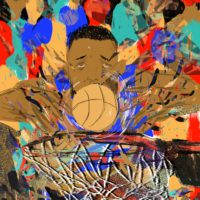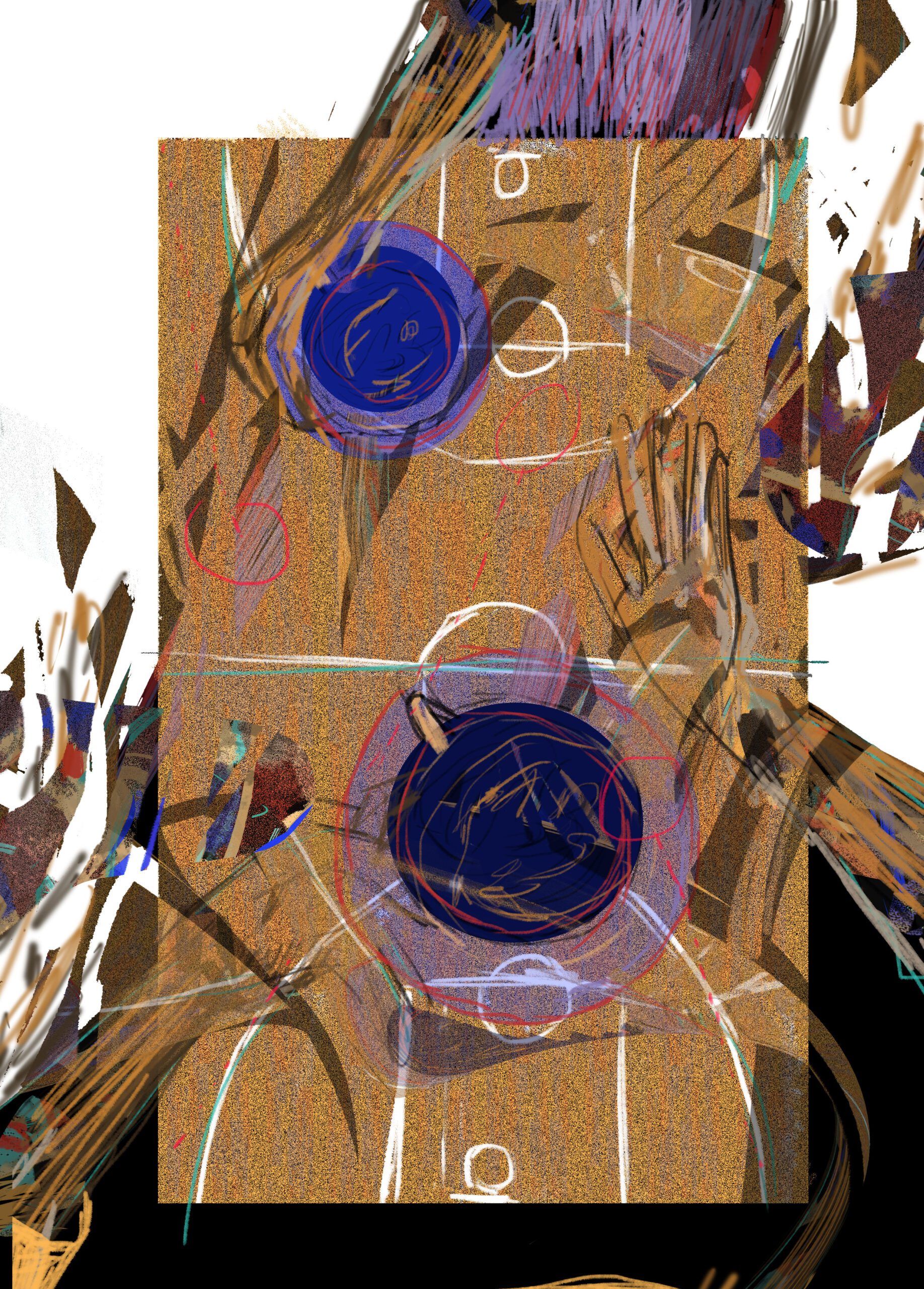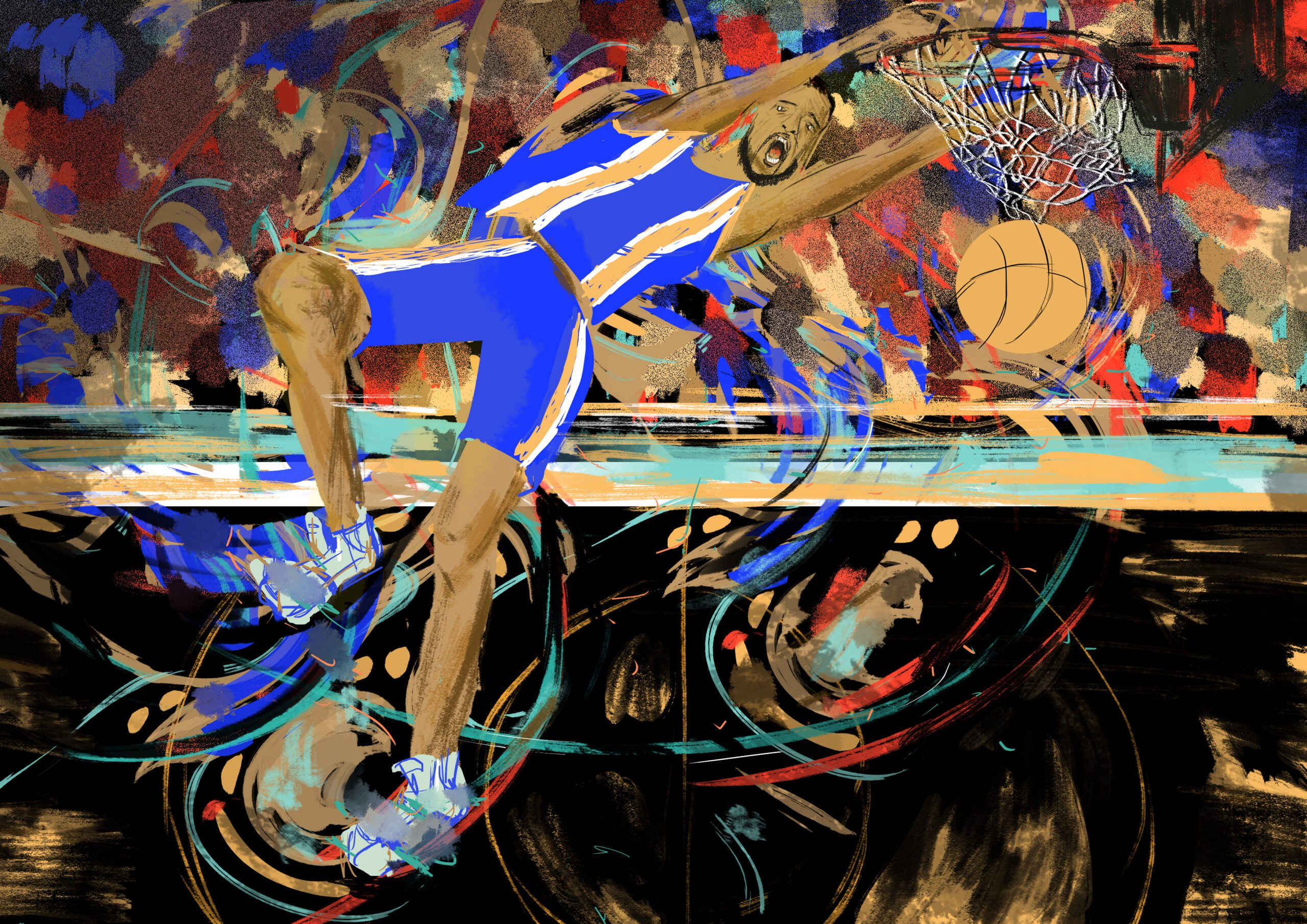There is at least one monster on every team. Monsters, beasts, fucking demons. They’re embedded within any roster, across various domains: the key, the plate, the field, the track. They are relentless scrappers whose strengths are not necessarily wedded to their physical size, though this is a common relation to draw. Some of their namesake is tied to their prowess, of course. They are faster and meaner and hardier than anyone facing them. They will cut you in half and the glory that shrouds them in the aftermath only makes them stronger. It is rare that you will be able to spot one on sight, but you will know their presence when they make their move. They are motivated by different things. I was always motivated by anger.
It used to be that I had to strip off my uniform and step into the shower at the end of the day before I noticed the litany of bruises that lay scattered around my upper body. This is what tens of hours a week in club basketball does to you. During practice, I would push my body to its uniquely painful limits, lungs clogged with mucus and what always tasted, to me, like blood; thighs spiked with sharp burning sensations that tightened my muscles if I stopped moving. All this in the pursuit of some kind of mastery, a perfection of movement on the court, within the web of the team, hewn from an adolescent body.
If you are expecting me to single out any one NBA player for extended meditation on what it might mean to fight through your thresholds and emulate your heroes, you will be disappointed. The truth is, by the time I stopped playing, I had come to hate basketball. Maybe it was the chore of it. I was black (to most people, at least) and my parents didn’t raised me to be lazy. I’d played in junior leagues since I could run. I’d usually been singled out for all-star teams. Why would we have considered pouring extracurricular money into anything else? Most, no, all of my childhood activities revolved around basketball. Sometimes, in my more melodramatic moments, it feels like I am working to reclaim memories of anything else from that period of my life.
Not everything forced upon you in youth is rejected. Yet few things drain you like the expectation to perform. I was playing a sport populated with people who look like me, that seeks to recruit people like me: tall, fast, lean where you can get it. People whose love and passion for the game typically exceeded my ability to care about it, even when the NBA playoffs started. At work here is a logic that says most people of a certain, very general body type make for fit players. Obvious physical traits are tantamount to skill and an innate feel for the game. My complaints would have ended there if that had been the case, some bodily truths that didn’t add up to much. But few things drain you like knowing that you’re good at the thing you are loathe to do.
So, after pulling my shots and throwing limp passes during practice, doing what I could get away with before either my coach or my dad called me out, I would lay everything I had on the court. Traditional elements of what make a monster depend upon whether the thing was ever human to begin with. If it was, then transformation is key. My transformations came from disdain and sadness and exhaustion. On the court, I was a monster born of negative emotion. I drove hard into the key, slapped the ball out of opponents’ hands, wrested the rebound high on a pivot that earned you elbows to the face or a hip check if you got too close. When you field contenders with a body that welcomes confrontation, it can be a frightening sight. I used to wish that was true when I played, that the sight of me would fend off my opponents. The truth is that, in the midst of a game, confrontation typically invites more confrontation.
Over time, as I played more and I grew taller, it seemed like I had broken through some sort of ceiling. In those last years before quitting, playing a good game felt easier than it had ever been. I was expending less energy; I could “see” the plays being made in the way my dad told me all the great players do. One time, I even garnered an enjoyable, slightly bewildering reward. At the end of a stint in Flight School, Michael Jordan’s youth basketball camp, I was awarded Most Improved Player, invited to receive the award center court from MJ himself in front of the entire congregation. Still, I barely remember the week leading up to that afternoon. All I know is I silently cried from exhaustion when I went to bed each night.
“Godzilla” was the informal moniker my teammates gave to me after I broke six feet.
What do we call the monster who knows it’s a monster and hates itself for it? More tortured soul than evil presence. And monsters are created, right? They can’t be evil. Are they simply outsiders or misfits? Misunderstood creatures whose inner turmoil would lend itself to peaceful coexistence if they weren’t constantly set upon by outside forces? An overused metaphor to help us understand what it means to be labeled as other? And what if those external forces actually want the monster to appear? What if they do everything they can to provoke it, to coax it back out?
I think back on my later years playing basketball with caution. Gradually, my body became capable of more activity. Often that activity entailed harm, harm that was encouraged by my coaches and teammates and, I will admit, relished by me. Of course, this was all limited to the court, and it is funny to me now to think of what it might mean to call on the beast that people cheer for when the beast later fights for its life outside the game. To think of what is contained, all that tenacity and unbridled life, and how it can be warped, as it was with me, into some kind of broken fury. To think about who gets to show fury and what the varied consequences of doing so can be.
During a game in middle school, when I played for the St. Elizabeth’s varsity team, one of my teammates got trucked by a player from the opposing St. Anne’s team. I had recently recovered from a broken finger that had forced me to learn how to shoot with my non-dominant hand. Even after the break healed completely, I favored my shots and shied away from direct contact with the ball. That game against St. Anne’s pulled me out of my hesitation.
In the second half, we were winning against a team notorious for playing rough, on their home turf. I remember seeing their coach red-faced, fed up. St. Anne’s wore bright red; we wore navy blue and green, the St. Elizabeth Eagles logo cribbed almost exactly from the Philadelphia Eagles. Following a time-out, St. Anne’s center, a kid I’ll call Max, slammed into our point guard even though St. Anne’s had possession of the ball. Their team was still running back on offense and our point guard had barely passed the half-court line. Max came up behind him and shoved him hard to the ground with both hands, at speed. Referees blew the whistle, called a foul, stopped the clock to check on the kid on the ground. Eventually, our point guard was benched for the rest of the half with a fractured ankle. St. Anne’s received no further consequences. But while the clock was stopped and my teammate was writhing on the floor as the school nurse looked him over, my coach leaned over to me, pointed at Max, and whispered, “That kid is yours.”
On our next possession, with our team at least ten points ahead, I waved for the guard to pass me the ball in the key, Max pressing up behind me with his arms straight over my shoulders. I remember thinking that I wasn’t going to shoot to score. I pivoted with the ball low at my belly, elbows out. I could feel that Max saw the opportunity to close the gap between us and as he stepped forward, I pushed the ball past his face, my elbow making contact with his nose. I missed an easy two points even though I shouldn’t have. But my coach and I knew I was really taking two shots at once. I didn’t miss one of them.
The period of my life where basketball ruled everything is a period most of my current friends don’t know about. They may catch glimpses of it when I’m momentarily transfixed by a nearby TV screening an NBA game, or if they spot my lingering gaze on a pickup game played under spotlights at night. What hurts is that I now miss the game. I miss it because I have the freedom of choice I didn’t have before, or at least didn’t think I had. I miss it because I can accept that there was some latent talent there, because some of my favorite nights were spent in the gym, years after I quit the game, playing pickup games with strangers far older than me, and holding my own. There wasn’t a monster in there anymore, not one subsisting on shrewd vindictiveness or spite. Some other beast was forming and then, like any unknown entity that looks malevolent but isn’t, I snuffed it out.
When I asked a friend if they could name any professional players who fit the bill for a “monster,” they pointed out how “beast” is the more common way of phrasing it amongst mostly black basketball players. Even then, the element of size came to mind. They named Giannis Antetokounmpo, the 6’11, 242-pound Greek-Nigerian forward for the Milwaukee Bucks. 6’11 may not seem impressive in a sport known for its tree-like players where the average height is 6’7 (which also happens to be my height). But upon searching for highlight reels of Antetokounmpo, it became clear why he’d come to mind. Giannis is fearless. He has impeccable court-sense, knows exactly when to dump the ball to another player and when to drive through the opposing team to the basket. Giannis has flair and follow-through. He has a confidence that comes from knowing what his body is capable of achieving. Watching those highlights, I felt my pulse quicken. I know what it’s like to take those long, stomping strides toward the line, leaving the ground, crashing into chests and shoulders, and still finish the shot. It’s like animal sense. It takes one to know one.
It is a peculiarity specific to sports that the alchemical concoction of talent, confidence, force, and single-minded drive results in a label that denotes something unnatural, something nightmarish, something dangerous. This is what it takes to be formidable. You are playing to win in a storm of bodies, bodies that are straining at the limit of their coordination. Perhaps, there is something to the idea of lending myself to a kind of physical single-mindedness. Something to the rigor that comes from having once shaped my body, or maintained a certain kind of shape, that had nothing to do with health and everything to do with the dogged attempt to win this one slice of the world. I think that’s the final piece of the puzzle. Monsters don’t play solely for the love of the game. They break through the storm. Monsters are irrevocable. They smile while they chew.
***
Rumpus original art by Tomekah George.







